A few years ago, a gourmet coffee maker contacted us about a new blend it had developed especially for sailors. As I recall, the medium roast was formulated to create a full-bodied taste and aroma when savored outside in the salt air. Sadly, my own stunted sense of taste can’t detect such nuanced flavors, but I do like a good cup of coffee on board. And this is a problem.
As far as I can tell, no one yet has designed the ideal way to make cup of coffee underway aboard a sailboat. With the hopes of sparing other coffee-lovers years of frustration, or possible injury, I’m sharing my experience with the several methods we’ve tried.
Instant coffee
We spent a couple weeks recaulking our ketch, Tosca, in Cartegena, Colombia and were chagrined to discover that Nescafe was served at all the restaurants in this coffee-producing country, prompting us to give it a try. Perhaps the South American version was different from the one we knew? Nope. No matter what water-to-coffee ratio I used, mine always seemed to have the consistency of motor oil. I’m told that Starbucks Via blends, sold in in planet-polluting, single-serve pouches, tastes better than most. On the good side, this is probably the easiest coffee to make on a moving boat.
Bottom line: For the truly desperate only. Tolerable with lots of cream and sugar.
Cowboy coffee
We were introduced to this method by a couple of Canadian conspiracy theorists in Fiji, who refused to buy anything made in an industrialized nation that they did not absolutely need. As I recall, all their meals – like their coffee – were made in one large pot. To make the concoction, they would simply stir course grounds into a hot pot of water and curse the CIA (in hushed tones) while they watched it simmer. They would then pour the oily liquid into a cup, trying in vain to leave all the grounds in the pot, which they later read like tea leaves.
Bottom line: A very big mess waiting to happen. And gritty. Recommended for cowboys and anarchists only.
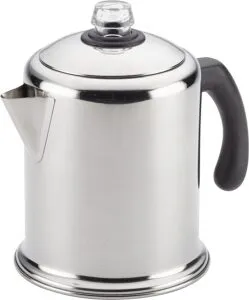
Stovetop percolator
We picked up one of these at a hardware store in Venezuela. It worked tolerably well at anchor, when the tall pot remained upright, but if you need your morning coffee fast, waiting intently for the telltale gurgle and drip (it seemed to take forever) is a sadistic form of torture. At sea, after repeatedly cleaning the filter basket after each pot and mopping up the mess when the pot tipped over, we soon found ourselves scouring the cabinets for traces of Nescafe.
Bottom line: Tolerable at anchor; a marriage-wrecker at sea.
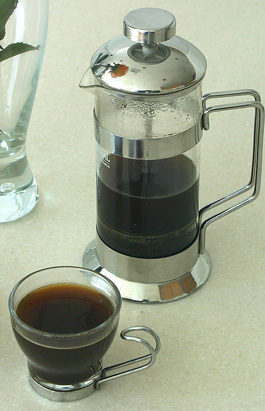
French press
I only recently learned that I have been using this wrong all these years, which might be why I never really fully appreciated the taste. The correct approach involves freshly ground beans of a uniform coarseness (apparently only achievable with a special kind of grinder), and a carefully timed steeping. Here are instructions on making “perfect” French press coffee, one of several sites that describe the process in detail. There are so many ways this process can go wrong that I don’t know where to start, but two words sum it up quite well “burr grinder.” In Fiji, we hosted some early-rising stateside guests, and they brought one of these noisemakers aboard, along with an elaborate coffee-making routine that involved much clanking and banging. It was an AC version, but it drew so little current that we could run it off our small inverter – something I regretfully revealed during an unguarded moment. The grinder soon developed a short circuit, however, and I was unable to fix this with my tool of last resort—a 24-ounce framing hammer.
Bottom line: If you decide upon this method, I suggest you keep the grinder well-hidden, and use it only when you are on board alone.
Stovetop espresso maker
We bought this at the same time we picked up the percolator. (Venezuelans have more kinds of coffee than we have breakfast cereals.) We were giddy with the excitement of making espresso (real espresso!) onboard, until we realized that this contraption, in the process of brewing, transfers all of the water from the bottom of the container to the top. This is akin to moving the lead in your keel to the top of your mast.
Bottom line: We heard of a juggler who was able to make coffee using this device – but only at anchor.
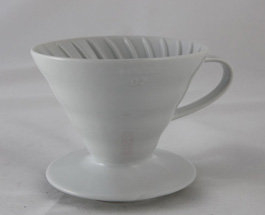
Manual drip cone
In the end, we settled for this method. It uses a funnel-type basket that accepts the same type of filters you use in drip coffeemakers. On long passages, we’d make one thermos full in the evening – in the sink, in case of spills – and this was usually accomplished without injury. You can also make one cup at a time. Like the Venezuelan espresso-maker, this is a top-heavy approach, requiring you to perch the funnel atop the thermos (or cup) and pour hot water into it. Ideally, the thermos and funnel would latch together, but I don’t think anyone yet makes a device that does this.
Bottom line: It works, but not without risk. A good teapot that pours without spilling helps prevent disasters. When it’s just me in the morning, I still make my coffee this way.
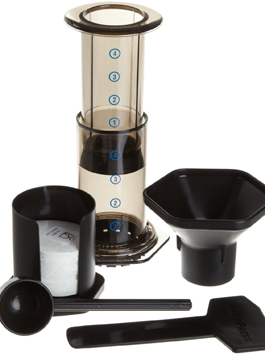 Aeropress
Aeropress
For those who crave espresso-style coffee, we’ve had good success with the Aeropress, which works something like a French press to make espresso. The “press” component is a plunger forces the hot water at a high pressure through a disposable filter that fits at the bottom of the chamber. It is an efficient way to make coffee quickly. You can make up to four cups, but we’ve found it works best with two cups. When you’re finished you can press the coffee and filter into the trash. There are also reusable filters, which we have not tried.
Interestingly, it’s made by the same company that developed the far-flying Aerobie flying disc. How someone made the connection between something you fling great distances and a contraption that makes coffee, I’m curious to learn. (I suspect it involves an incident with a burr-grinder.) Anyway, if you have found a way of making coffee onboard that won’t drive me further over the brink, I would be delighted to hear it. I’m sure there are other long-suffering under-caffeinated sailors who would appreciate your wisdom, as well. We’re especially interested on cold brew blends and techniques. You can reach me at [email protected].
For more on designing, stocking, and outfitting a cruising galley that is as functional at sea as it is at anchor, as well as tips on cooking at sea and provisioning for long voyages, check out our three-part ebook series Galley and Onboard Cooking.





























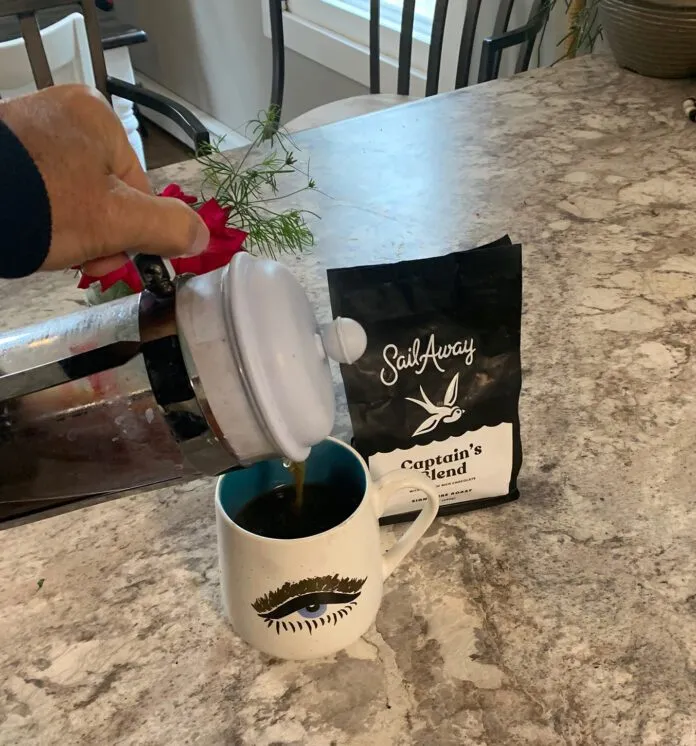
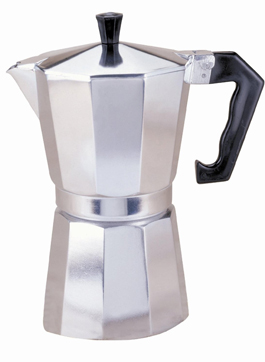





very good article! How about cold brew? It’s a learned process to make it, but I’m wondering if you could make it ahead of time and then heat it when needed. FYI : the old fashioned perulators produced the most caffeine. Put the grinds ion the s/s top part and no filter needed.
We are big Aeropress fans. I view it as a small, filtered prench press.
I have yet to find a compact burr grinder. Any suggestions?
JavaPresse makes an excellent manual burr coffee grinder
The key to compactness is a manual grinder. We’re happy with our Comandante grinder.
I normally use manual grinders and I haven’t had any issues, and love the quality of the coffee it produces. Also used a mortar & pestle for years because it was cheap. No issues with the french presses (for us). I also have a metal french press and love it – no glass to shatter!
Good article. I agree that a good solution remains elusive 😊
I use a manual burr grinder set for a course grind, a jet boil with its french press lid, and make a couple of small cups at a time. Works well so far. Steeping time varies to taste, but I like to steep for 5 minutes. I also give a quick stir of the coffee in the jet boil before putting on the french press lid. Not too complicated and a good cup of coffee. If I am planning for rough seas I put it in a thermos.
I second the cold brew. My wife chose it for the lack of acids released by hot water processes, with the added convenience that she can make a 2 week batch in advance and heat water as needed (I make tea or instant from the same kettle). Of course, it’s one more item in the refrigerator. Maybe the search for the perfect instant should be added to the list of sailors’ Holy Grails, like forever bottom paint or non-smearing caulk.
The solution is to sail a catamaran.
KaChinggg!!! In my case it’s a small folding trimaran (Corsair F24). I use a hanging stove in the tiny cabin. In the fiercest weather I can still safely boil water, turn around and pour it into my stainless steel thermos-like French press placed on the cockpit sole: 3-4 cups of good-enough hot coffee using sealed pouches of “fresh” ground coffee, although I’d prefer a paper filter. Cleaning is a breeze w/o fear of breaking glass.
That said, I’m going to look into the Aeropress v
AEROPRESS! We own 4 of them. One stays on our boat, one in our teardrop trailer and 2 at home.
We’ve used it for years: canoe tripping, backpacking, car camping and live aboard.
The puck of used grounds is easily disposed in the trash with next to no liquid. Makes great coffee!
Hi Hugh! While I have only one AeroPress, I too am a big fan. Best cup I have ever tasted.
Hilarious. I have tried several of these but find the aero press the best by far. It is indeed low volume but you can make it as strong as you want and add water to the cup once your espresso has been extracted. I make a large batch of the strongest espresso I can and keep them in a container in the fridge and pour over ice with cold water in my thermos mug in summers, and of course with hot water in winters. For the best instant coffee in the world try Lavazza.
I realize your tongue was firmly in your cheek on this one, but I’m happy with the stainless steel french press I picked up at Walmart for $20 something a few years ago. I can’t taste the difference between fancy burr ground and run of the mill grocery store, but if guests want to bring fancy coffee and time the process with a stopwatch, they can have at it. The mueller’s probably not 316 and will show some discoloration, and the internal plastic filter parts will fail, but the pot itself is robust and double wall insulated. Still whole (not even dented) after several wake related drops from the salon and cockpit tables. https://www.walmart.com/ip/Mueller-French-Press-Double-Insulated-304-Stainless-Steel-Coffee-Maker-4-Level-Filtration-System-No-Coffee-Grounds-Rust-Free-Dishwasher-Safe/455886923
Captain Pedro calling. Bodum have an insulated French Press which we use on SV Tula along with pre-ground coffee. The grounds always go in the garbage and not down the sink as gray water. Fish and crabs do not need more caffeine. We have pondered adding an expresso machine similar to the one here at home. Dunno if the 2,000 watt inverter would handle a small machine…….
I use grocery store cold brew mixed with room temperature water. Luke warm coffee is an acquired taste. When I can I purchase Vietnamese instant coffee. It is very sweet and creamy but is also loaded with caffeine.
I suspect that any method that uses coffee grounds contributes greatly to pollution as most cruisers will have few options but to dump their “biodegradable” grounds into pristine waters.
When we moved aboard, we brought our Jura coffee maker from the house. Grinds and makes excellent coffee one cup at a time at the touch of a button. Fits in appliance hutch built into the galley wall. Would not want anything else!
Manual burr grinders can be had from camping supply stores like https://www.rei.com/search?q=coffee+grinder. I bought a brass one in Greece years ago, and it works well.
We get coffee pre-ground for our Aeropress and it works just fine, though I’ve never tried it in a under way.
this is a good , cheap, battery powered, grinder! https://www.amazon.com/gp/product/B09X4473SC
Aeropress with the Fellow Prismo attachment. It’s a $30 attachment that’s supposed to allow for more of an espresso style crema, but it also is much more secure and leak free than the original.
Love the good humour. I use Aeropress and sometimes the italian stove top. Aeropress makes a tastier cup. Btw, the guy that invented it is a scientist , Alan Adler, use to work with cooling systems for nuclear plants, in some way. He loves coffee and wasn’t satisfied with any of the machines available so he invented a good and simple one. He didn’t like the performance of frisbees either (very short flies) so he made one (aerobie) that went over 300ft or so.
Here is another champion of cold brew. We let ours steep cold for 8-12 hours which makes a concentrate and lasts for at least 2 weeks in the fridge. If you want it warm/hot, depending on desired strength add 2 to 3 parts boiling water to 1 part cold brew. As stated earlier, the acid content is much less than hot brewed.
I’m no connoisseur, but I’ve been enjoying the Starbucks VIA instant for years of sailing, camping, and at my island home in the West Indies. Each sealed packet is about the size of your pointer finger, will keep indefinitely, and can be bought at Starbucks (duh), at groceries (expensive), or at Costco (my choice). There are various strengths and aromas. Try it. . .I think you’ll enjoy it. If nothing else, keep it aboard for those times when your coffee stash is full of salt water or mold.
Aero press is great! Just add hot water to your espresso for a delicious Americano.
They now make a much more compact version — the Aeropress Go. All the parts fit fit inside your personal mug and a cap on top. That large 5-sided funnel that sits on your cup is gone. Tucks into a corner of a cupboard or knapsack. I have 2 of them.
A burr grinder completes the tasty preparation. Micro filter paper means no grit in your cup (Fr. press) Keep the grinder at home. grind enough for a few days.
Thanks. We make cowboy coffee ashore and mix a raw egg with the grounds. If simmered gently the egg coagulates into a coffee omelet capturing the majority of the grounds. When done pour a teaspoon of cold water over the omelet and it sinks, leaving clear coffee to be poured.
This is great for a calm anchorage, probably cooks too long to be effective offshore.
If you drink instant coffee the terrorists win. Despite the (admittedly humorous) description above an insulated french press is easy and foolproof for us. Ours is made by Frieling. Hand operated ceramic burr mill perfectly grinds the beans every morning in no time at all. The entire coffee making process takes place over/in the sink, which is where the french press pot stays until it is empty just in case it tips over. Which happens.
I have made coffee, while camping, by making a huge “coffee bag” using a 4×4 gauze bad and some cotton line. Put it in my blue perk pot (I had forgotten the perc parts) Best coffee ever, hands down. Can’t wait to try it on our new-to-us boat.
The flavor from coffee is best extracted at high temperature (96 °C or 205 °F), without paper filters which absorb the aromatic acids. If you want flavor, skip the drip and plunger (steeping for 5 mins or so does little for flavor) and use an expresso-type on the stove top. Beware, some are prone to toppling with the process complete, and the end result is extremely hot. If you must use a drip, use a metal filter.
My personal favorite when off the dock, a Bialetti in stainless steel, made in Italy.
Note above boiling point releases bitter acids.
I just chew a small handful of roasted beans followed by a drink of water. Maybe not as enjoyable as a streaming hot cup of coffee but I still get coffee even with added fiber.
I love French Press coffee ( I pre-grind), but find the cleanup on the boat was very water hungry to clean up later. Then I found some paper coffee condoms on Amazon – they slide inside the press and keep the coffee grounds contained. Easier than a perk.
Im ver satisfeito Wirth de aeroprrss. Good IDEA.in mto sailboat. Here. Um Imbituba sc Brasil. Good.
Great article!
For grinding we use the JavaPresse Manual coffee bean grinder. It’s easy to use, has 18 coarseness settings, and uses no electricity.
For regular coffee we use either the Stanley Travel Mug French Press or the Stanley Stay-Hot 48oz French Press. Both have proven idea for boat coffee as they keep your coffee HOT! The travel mug press is the best I’ve used for an individual (16oz) serving. Put in your coffee, add water, wait a few mins then push down on the press, screw on the lid and you have hot coffee that won’t spill while you tend the helm.
For espresso we use the Wacaco Nanopresso Portable Espresso Maker. It makes an excellent espresso and uses a manual pump to create the pressure (18 BAR!). We ended up getting the ‘Barista’ accessory kit as it has a larger water tank and basket, so you can make double shots.
All these items have proven easy to use and clean up.
If you are serious about your espresso, as we are, the ROK is easy to stow, and whatever your roast, delivers a highly concentrated perfect shot.
https://www.rok.coffee/espressogc
An alternative to a purpose made manual drip cone is a silicone funnel combined with a Chemex filter. Put the funnel in a wide mouth thermos or large mug. The set up is more stable than the typical drip cone that sits over a cup. The funnel can find other galley usage.
For gourmet results, wet the coffee and allow it to “bloom”. Then pour in more water.
https://www.drinktrade.com/how-tos/chemex
This solution was previously published in Practical Sailor.
https://www.practical-sailor.com/boat-maintenance/mailport-february-2014 at bottom
We’ve used a Bodum, and now my Keurig sits unused except when I’m running late. My wife and I are going camping into Isle Royale National Park, and are going to try “Coffee Bombs”, which is coffee in a basket filter tied at the top, steeped like tea. We’ll see.
Used to use the ‘inverted’ Aeropress method, until an unfortunate accident and a very scalded hand. Replaced with a Bobble Presse, which is effectively a French press insulated cup all-in-one doodad. Since there is only about one cup drunk per day, it’s working for us.
You answered your own question: “in Cartegena, Colombia and were chagrined to discover that Nescafe was served at all the restaurants in this coffee-producing country”.
Coffee is supposed to taste like motor oil. Embrace the suck. Use sugar and cream if you’re weak. 😉
Must be a slow day at PS.
+1 Bodum. Easy for those used to a drip machine at home. Clean out with the water all about the boat & final cleanse takes only ounces of fresh water!
Coffee pouches are available but $!
Instant is easy but you need to find a ‘favorite’ and amount for your cup!
More important (for our crew) is an ‘Airpot’ thermos & dispenser all in one. You have ‘pumped’ them in any fast-coffee setting… just fill with (almost) boiling water (save fuel!) in the morning and be set all day (or night if under way – perhaps more important for safety!). Got mine for $1 (dented at Goodwill store; your prices may vary!). Designed to survive ticked off employees & rough handling & my kids.
Your mileage may vary 😎
Like many commenters, I have an AeroPress on board. The colleague who gave that to me as a gift just alerted me to the Fellow Stagg [X] pour-over dripper, which makes 1 cup at a time into an insulated glass mug (multiple cup version available as the Stagg [XF]). It wins hands down on esthetics, seems unreasonably expensive ($80 for 1 cup, $99 for the larger version) and in my opinion would need a lid for safe use while underway. However, it strikes me as an improvement over the pour-over filter, just from a stability and design perspective. And if the company dubbed it the “Nautical Coffee Maker”, the price would instantly look a lot better (seeing that anything “nautical” tends to be up there in price…).
Stovetop espresso makers, aka moka pots (Italy) or cafetiera (Cuba), are finicky to use on shore. Narrow margin between not done and burnt. Works at home if you are attentive.
Tried it on a big catamaran and it was a painful process of holding its narrow base carefully over a too large propane stove burner. Burning myself on the flames or melting the plastic (always plastic) handle, or flinging boiling coffee on people was not worth it.
Unsuitable for moving catamaran, may be unsuitable in an anchored monohull. Leave it for home.
BTW, it does not make “modern” espresso, but it does make a strong coffee in small to modest amounts. It was designed before WWII in Italy and the coffee it made was similar to that of the very low pressure espresso machines of that era
Cold brew made the day before would be the safest while underway (no need to boil water). Cold brew sounds great in the tropics but less so for cooler sailing climates. Drinking 2 week old cold brew sounds unappetizing at best – sorry.
When I was in Perth AUS in 1980, I stayed with a family for a few days and although they were not avid coffee drinkers, they fixed me up with a java that, although sounds less than stellar, was not bad. They used instant Nescafe (I think only coffee over there) and instead of putting hot water in it, they used hot milk (direct – no water) …. it was not nearly as bad as it sounds, and pretty simple … on occasion I have repeated this …. but if you drink your coffee black, obviously this would be less than pleasant … just an idea for you to try in a pinch.
Great article. I’ve seen a number of designs for gimbaled JetBoils. That would seem the safest way to make a few cups at at time without clogging up the galley. Quality instant and some non-refrigerated creamer is all you need.
I have not seen a gimbaled JetBoil. Does it attach to the stern rail? Heating the water and handling the boiling water and coffeemaker can be dicey in rough seas.
Single person combination press plus travel mug would be the easiest way to make hot coffee. No messy decanting from a pot into mugs on a heaving upwind beat. Typically 8-12 oz of coffee, a normal size cup. Make and drink out of the same contraption. Usually some variation on the “French” press which is actually from Italy.
– Best conventional one is Espro P1 or P0 with much better than average filters keeping the grit out. $40+
– As mentioned by another poster, the Bobble Presse is an innovative take on the combination press and travel mug, From the website it appears that a new and improved version is on the way but original still on Amazon for $24
– The colorfully named Pipamoka from Wacoco (say that fast three times) is not too dissimilar but uses vacuum instead of pressure. Importantly the grounds are confined to a small metal pod for easier than most cleanup. Fascinating mechanism.
– The BruTrek OVRLNDR travel press with BruStop (who comes up with these names?) is bigger at 24 oz and can be used as a solo big mug or poured into other mugs. It semi- confines the grounds to a screw-off bottom. Easier to clean than a conventional press and it has no vowels!
I think the aeropress is hard to use on a moving boat, but it is easier to clean as the puck of used coffee pops directly in to the trash.
Been using an AeroPress for years and love it. Thermos makes a insulated stainless steel french press that makes more coffee and keeps it warm a long time if you don’t want to dirty a thermos. The only problem is it’s not transparent so a little harder to estimate how much is left in the pot. By the way, the inventor of the AeroPress is Alan Adler who also designed the Fast 40. The 40 foot, 4000 lb. ultralight trailerable (8 foot beam) monohull.
It’s always interesting to read Americans writing about coffee; an entire county almost devoid of coffee! So coffee is just hypothetical until the revelation of Latin America (including Florida).
We use an automatic espresso machine (from De’Longhi) that grinds the beans and makes the coffee. It runs easily on a 2 kVA inverter. It doesn’t tip over as it’s strapped down. (Espresso coffee in gusting 48 kt. If the fear doesn’t keep you awake, the caffeine will.)
This seems expensive, but for roughly USD500 for each of the machine and the inverter, you’ve paid yourself back in 500 coffees. For a proper caffeine addict, that’s less than a year.
Avoid Nespresso unless you like coffee-coloured warm water. Their tiny capsules contain insufficient coffee at inflated prices. Double shots can be tolerated.
Otherwise, a French Press makes the closest to a real coffee. Bodum even has metal ones to withstand flying across the cabin. Their glass ones are somewhat fragile. Both Zylis and Bodum make insulated cups with an in-built press. This saves pouring the coffee into a cup.
Coffee grounds are no different to your other compostible waste. Put them with your vegetable pealings and dispose the same based on your local rules.
Ric, “Future Days”, Hobart, Tasmania
I read the ingredients on the Starbucks instant and it is basically instant coffee with grounds added. Because of that I took some of my favorite instant coffee which is Nescafé and added some finely ground coffee grounds and shook up the can. I’m able to take a small amount out of that and make instant coffee that tastes very similar to what I call real coffee. It costs almost nothing and I don’t use the single servers. I probably use twice the grounds that a single serving pouch has. You have to experiment with how of course you want your ground beans. I grind my 100% Colombian coffee grounds in my grinder to make them more fine. Thanks for the fantastic article. I love the humor.
Great tip! I’ll have to try it.
I keep a Revere Ware french press aboard for the special occasions I may have fresh grounds needing hot water. The press sits on top of the coffee pot proper, so I can use just the pot to heat water. Years ago, I was introduced to coffee in a pouch (Maxwell House filter packs) on a camping trip. Oh, the joy! A tea bag full of ground coffee big enough for a pot. Just bring the water up to temperature and drop it in. The hardest part is putting water in the pot. I make a pot in the morning (or whenever) and either decant into a thermos or just put the pot in the sink if underway. The used coffee bag nestles quietly in the trash bag after I’m done.
As a KISS proponent without a fridge I’ve had fair success mixing equal parts instant coffee with full cream powdered milk. Experiment with brands, proportions, especially how much water.
Our totally impractical answer was to buy a beautiful little Pavoni manual espresso machine. Each morning we hand grind the beans (my daily workout), start the generator, pull our shots & foam the milk.
We then sit down and enjoy our great coffee. It fills in a few minutes & has become our ritual. Life is too short to drink rubbish coffee.
All good below a 2 metre swell 😄
Ya da man! I use an LP at home.
Thank you for all the comments, especially cold brew. We are actually trying different coffees that claim to be meant exclusively for this purpose. If you have a favorite blend for making cold brew, or experience making it, we’d be interested in hearing details at [email protected].
My favorite brew method on the boat is Aeropress. I have two and batch hand-crafted coffees for my guests and me. I used the inverted method, which combines the best of pour-overs and immersion. Double the filters, if you’re using paper, and you will give a clearer cup.
The most important thing is using freshly grounded fresh whole beans. While you can splurge on electric grinders, for all methods (other than espresso) I recommend a Hario Skerton hand grinder. Get one with stabilized burrs for more consistent grind size. The new Skerton comes with stabilized burrs; custom kits are available for old ones. Hand grinding for multiple cups can get tiring, so I use a 12v Milwaukee cordless drill with a grinder adapter (3D-printed from Shapeways).
I vacuum seal my beans 5-7 days off roast in 100g bags and freeze them. Then I pull one out and store it in a small Airscape. Then grind fresh for each brew.
I heat Half-n-Half on the stove and froth with a battery-operated frother for macchiatos and lattes.
I don’t make coffee while underway, but if I were to, I’d use a Mocha pot. We have our coffee before shoving off.
Having great coffee onboard is not difficult, but it takes a little effort and planning. Just like on land.
-Bruce, 1982 TaShing Panda 40 Pilothouse
If you’re not enjoying instant coffee, the biggest reason is user error. I spent months in New Zealand cursing every coffee I tried (they have heaps) before I realized that when you used less, it tasted a lot better. All of a sudden, the difference between a high priced and low priced instant made sense.
Pro tip: high end coffee with microfines (eg Via) are best enjoyed hot. Middle of the road coffees are best enjoyed shaken cold: you’ll get a pleasant foam in your bottle/mug.
If you’re looking for a coffee appliance, an inverted Aeropress is my go to. You can drill two holes in the rim and suspend it from your grab rails on thin line in a bad sea state. Replace the paper with a stainless filter for sustainability and French-press like flavor with all the oils. While a burr grinder is key to *any* coffee, there’s no reason to buy a powered model when a hand grinder will do.
I’ve been using a jetboil to heat the water and pour it into a french press that forces the water through a re-usable Keurig style cup with recycled-paper filters. Quick, easy to clean up and I use whatever variety of coffee I want. I can do it while anchored or while under way with the tiller pilot holding a smooth course!
Yeah, I too am an Aeropress fan. It allows me to make coffee for the Admiral that she can tolerate.
Yeah, I too am an Aeropress fan.
You can reuse the standard aeropress filters quite a few times.
I don’t see a problem with a cafetière. My default when I’m making more than one cup.
The filter cone is a scalding waiting to happen.
We have a totally different coffee process. We have been using, for 20 years now, and love it… the Coleman burner top drip coffee maker (https://www.coleman.com/grills-stoves/kitchen-essentials/camping-coffee-maker-10-cup/SAP_2000038223.html) . Using bunn filters (from walmart). the best filters I have tried..and cheap!
You put it on your cooker burner, heats up the water, does a proper drip coffee in about 10-15 minutes. It comes out hotter than what you can get at home, with traditional home coffee makers.
For grinding the beans, we use a portable battery operated BURR grinder! ( https://www.amazon.com/gp/product/B09X4473SC ) Takes about 5-7 minutes to grind enough for 6 cups.
A bit unorthodox but been working for us
On the coffee maker, I stripped off all the sneak a cup feature, as it tended to leak or fail.. Got to protect the glass carafe. I would not use it in rough conditions. We only use it at anchor.
If you got the time, this is a great way to go!
These guys, Sollevato Coffee, have a cool single serve coffee option that comes fully self-contained in a steepable package. You make it like you would make tea, but its coffee! It’s great because all you need for it is water and a cup. https://sollevatocoffeeco.com/collections/single-serve-coffee/products/single-serve-coffee
I use a Bellman Stovetop Espresso maker and steamer on my 52’ mono. The arms on the stove easily hold it in place and it makes an espresso or milk based coffee brilliantly. Team it with a good manual grinder and you have the ability to make excellent coffee of almost any type easily.
I searched long and hard for something, I’ve enjoyed plunger, mocha pot and drip over the years, however being able to make real milk-based coffee with steamed milk is a joy if that’s your thing. The Admiral is impressed.
Great to see so many responses. We take our stimulants seriously!
In our experience the Aeropress works well and has minimal waste and cleanup. But our second one developed an unpleasant gooeyness to the soft plastic plunger that creeped me out.
So we’ve gone back the the “Clever Coffee Dripper”, a cone filter holder with a stopper valve in the bottom. I can steep a load of grounds as long as I want. 4 minutes is the current favorite. It only requires balance assistance/ supervision when placed over the mug for the 30 seconds or so to drain. Cleanup is the minimum water conceivable. A mere swish.
For grinding, we use the Hario ceramic hand grinder. It keeps me busy while the water heats up.
Enjoy!
Drip coffee onboard. This company might have a boater at the helm.
Their drip is a tight little setup (although the glass funnel is a little vulnerable). The coffee is flavour is sublime and flows straight into a double-walled thermos. Add a cone paper filter and the process of clean-up is easy. They offer a traditional handle pour setup also.
https://asobubottle.com/products/pour-over
& Cold Brew
https://asobubottle.com/products/cold-brew